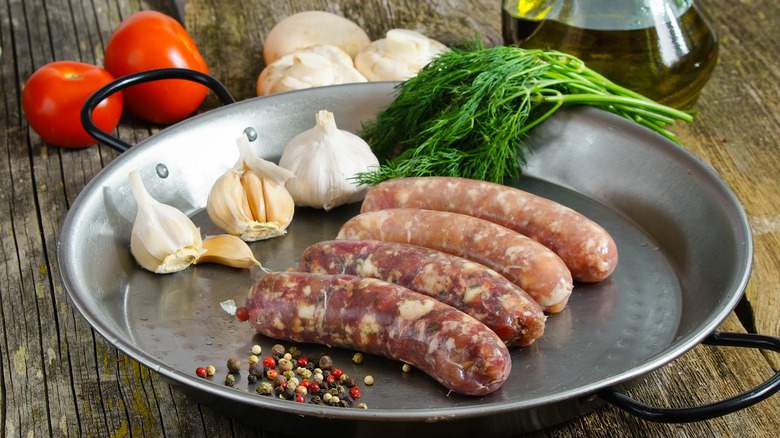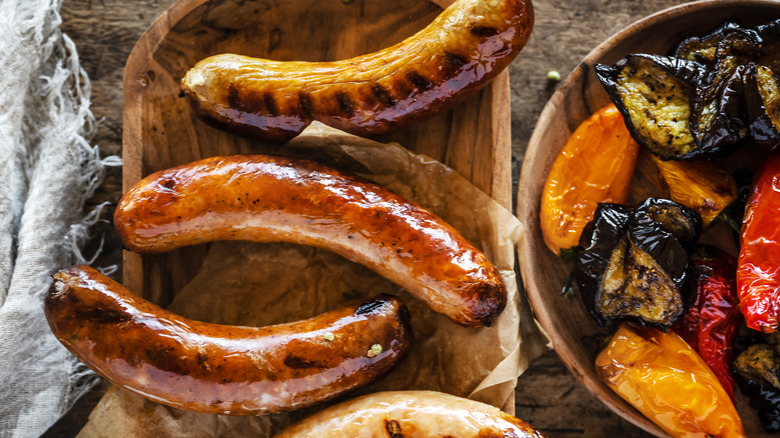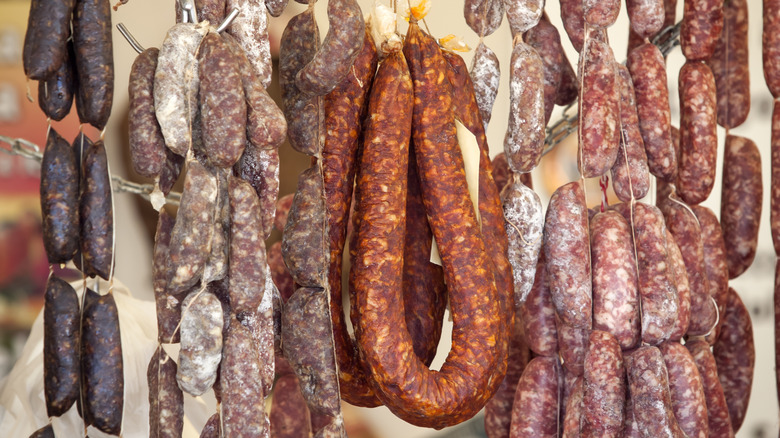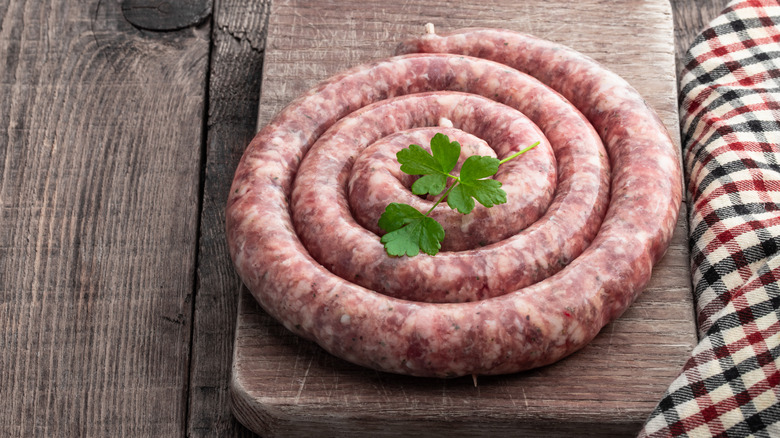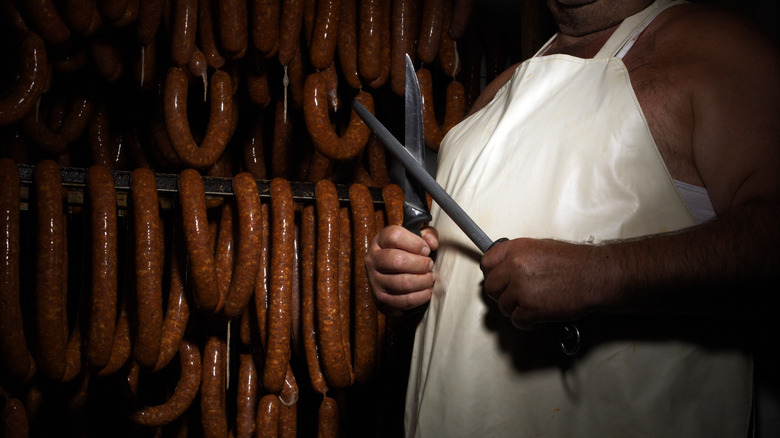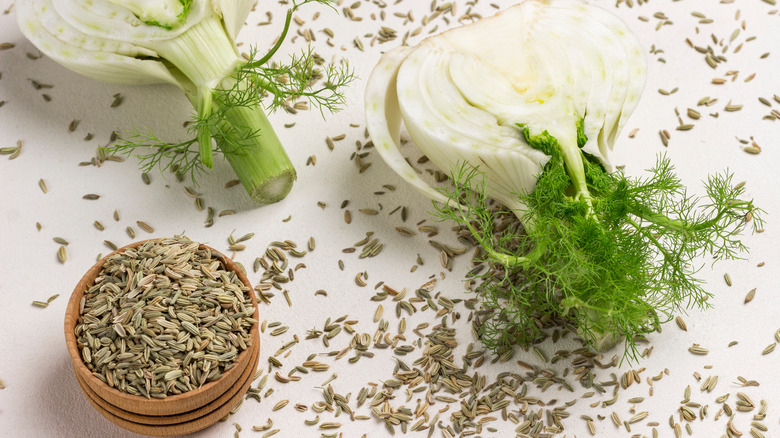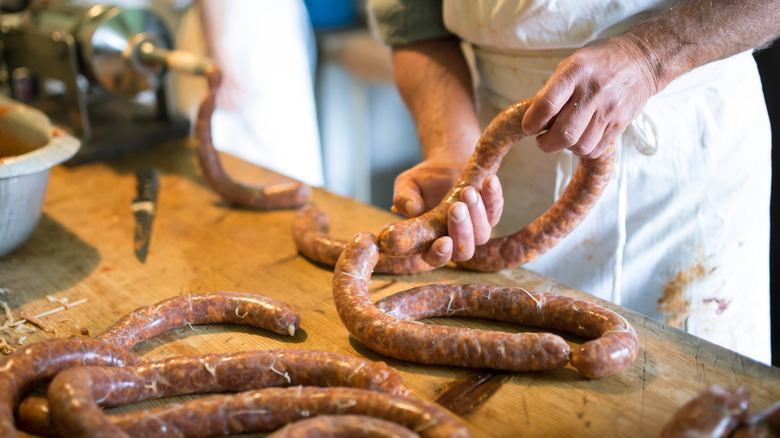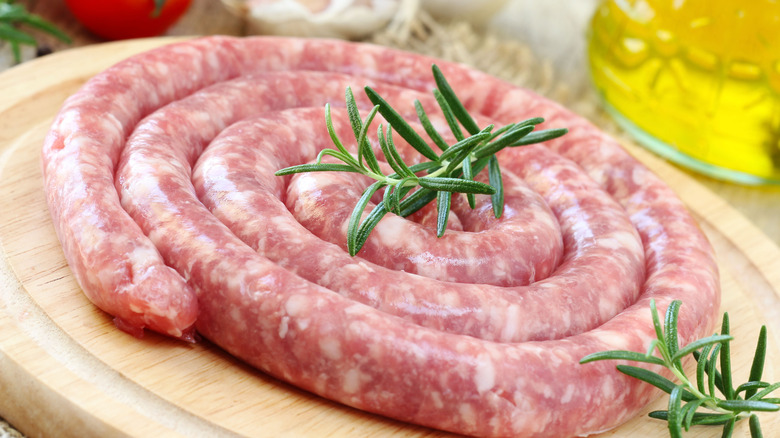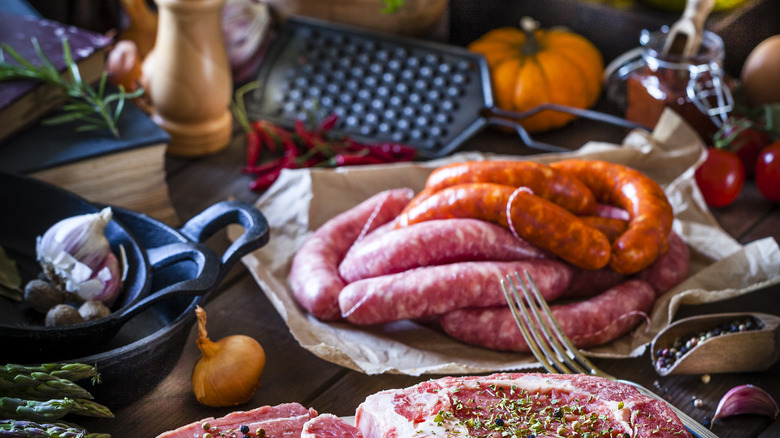The Ancient Roman History Of The Italian Sausage We Eat Today
While there are countless different styles of sausage throughout Italy, what many know as Italian sausage is most commonly a thick, encased pork sausage that's typically flavored with fennel and other spices and herbs. It's a fresh sausage, as opposed to a smoked or cured sausage, which means the meat is raw and must be cooked before consumption. In Italy, this style is known as salsiccia.
You've likely had it on pizza, tossed with pasta or layered in lasagna — or even grilled and served on a bun with onions and peppers. Italian sausage is versatile and varied, ranging from mild to hot, and welcome at every meal from breakfast to a midnight snack. But did you know that a version of this sausage has been around for thousands of years, since the days of the ancient Romans?
The act of mixing pieces of meat and fat with salt and other flavorings, then stuffing them in a casing to be preserved or cooked, has been around nearly as long as human civilization. And surprisingly, it hasn't changed much over the millennia — if you time-traveled to ancient Rome, you might find yourself enjoying a sausage with very familiar flavors.
Sausage predates the ancient Roman era
The true origins of sausage are impossible to determine, likely because many cultures across the globe independently discovered the technique of sausage-making on their own. It's a practical way to use every part of an animal, including the intestines or stomach which serve as the casings, along with offal, blood, and less desirable cuts of meat that can be chopped or ground for the filling. Additionally, in the time before refrigeration, sausages could be cured or smoked to provide a preserved supply of food, which would have been crucial for survival.
Smoking food for preservation is thought to have been around since prehistoric humans discovered fire, while curing meats using salt shows up in the historical record around 3000 B.C. in Mesopotamia. The first description of sausage-making also comes from that region, around 2000 B.C. In the following centuries, more evidence of sausage-making pops up in Babylon, Egypt, Greece, and China.
There are passing mentions of sausage in several Roman texts, but the first full recipe for sausage appears in a book originally titled "De Re Coquinaria" (translated to "On Cookery"), thought to be from the fourth or fifth century C.E. The author, or authors, is unknown, but the text is frequently attributed to Marcus Gavius Apicius. The recipe itself is not too different from Italian sausage today, calling for minced meat, fat, and spices, forced into a casing and smoked.
There were many varieties of sausage in ancient Rome
Without detailed descriptions or full recipes, it can be challenging to know exactly what kinds of sausages the ancient Romans made and consumed. But there are some clues that can point us in the general direction of a few different styles that existed, showing up in texts from writers of the time.
The word tomaculus, which in Latin means sausage, shows up in the writings of Juvenal from the second century A.D. It's mentioned along with pig, so we can presume he was referring to a pork sausage of some kind. The same word shows up in Petronius' "Satyricon," along with black pudding, a type of sausage made with blood, which is known today for its prevalence in British cuisine — perhaps brought to the region by conquesting Romans. Mortadella sausage can also be traced back to ancient Rome, then known as farcimen murtatum in Latin, referencing the use of myrtle as seasoning in the sausage.
While there is precious little detail we can glean from these minor mentions, it's clear that the ancient Romans had many varieties of sausage at their tables, and most of them appear to have been made from pork. Smoking and curing were presumably common practices to protect sausages from spoiling during this era, so many of these would likely resemble salami more than they would the modern version of Italian sausage.
Lucanica was the ancestor of modern Italian sausage
The ancient Roman recipe for sausage called it Lucanicae, which presumably referred to an area known as Lucania. This is now the modern-day region of Basilicata, which lies in the southern part of Italy, smack dab between the heel (Puglia) and toe (Calabria) of the boot. The recipe for the region's specialty sausage was recorded in "De Re Coquinaria," and amazingly, not just the recipe, but the sausage itself, has lasted through the centuries. Today, it is known in Italy as Lucanica sausage.
Although the recipe simply calls for meat, it's presumed to be pork, as that seemed to be the most common type of meat used in similar dishes at the time. The meat was mixed with fat and pine nuts, along with familiar spices cumin and pepper, and herbs rue, savory, and parsley. Another ingredient, which Apicius called liquamen, referred to a type of fermented fish sauce. Noticeably, fennel is absent from this recipe, although in modern Italian sausage, it's now ubiquitous. It's possible the Lucania sausage did have fennel, and it simply wasn't recorded by Apicius, or it could have been a later addition.
These ingredients, once mixed, are then fed into a sausage casing, roughly described by Apicius as a thinly stretched intestine, and suspended over smoke. This step is different from modern Italian sausage, which is fresh, but likely had to do with the greater need for preservation at the time.
The ancient recipe for Lucanica includes an unusual ingredient
As mentioned above, the ancient recipe includes an ingredient called liquamen. This ancient condiment, like so many things, made its way into Roman culture by way of the Greeks. It consisted of fish fermented in brine for a few months, then strained, which left a salty, savory sauce that could be added to all kinds of dishes. In fact, liquamen shows up in hundreds of recipes in the ancient Roman cookbook, "De Re Coquinaria." Alternatively, it's known as garum or garon. Comparing it to items available in today's world, it's most similar to fish sauce and somewhat like soy sauce.
You may notice that in the recipe for Lucanica, there is no mention of salt as an ingredient. Presumably, liquamen served the same purpose as salt, used as seasoning as well as imparting its own flavor. Because it's liquid, it would also mix easily with the other ingredients of the sausage. If you want to recreate an authentically flavored sausage from ancient Rome, liquamen or its modern equivalent is a necessary addition.
This sausage's popularity spread as Roman soldiers traveled
In the days before food blogs and cooking shows, dishes and recipes had to spread the old-fashioned way — through word of mouth, by people traveling from place to place. Some of the people in ancient Rome who logged the most mileage were soldiers, who were often stationed in faraway garrisons, particularly when the empire was at its peak and spanned the areas surrounding the Mediterranean and the Black Sea, and from north Africa to the British Isles. As soldiers moved from station to station, they got to know the local foods and brought their knowledge back home with them.
Lucania was originally inhabited by a tribe known as the Lyki. The Greeks showed up and colonized the region around the eighth century B.C., followed by the Romans about 500 or 600 years later, who sent soldiers to keep the area under control. When they returned to Rome and beyond, they brought Lucanica with them, as the smoked sausage was preserved and kept well on the road. We don't know what it was about this particular style of sausage that captured the Romans' fancy, but the fact that a version of it is still made today, thousands of years later, certainly speaks to its popularity.
Sausages were once banned for their relation to paganism
The ancient Romans had many festivals derived from pagan traditions. One of these was known as Lupercalia, which some believe was the origin of Valentine's Day. This February festival, in honor of a fertility god named Lupercus, involved some unseemly activities including ritual animal sacrifice, along with the less horrifying tradition of a feast. The banquet often included sausages of pork and pine nuts, such as Lucanica.
In the fourth century A.D., Emperor Constantine I converted to Christianity, becoming the first Roman leader to do so. In the year 320, legend has it that he outlawed pagan festivals and, along with them, sausages. Because sausages were so closely tied to many of the feasts and rituals surrounding these holidays, eating them was considered sinful by the Catholic Church. Of course, this didn't stop people from making or eating the sausages — they simply did so under the radar, and the world of sausage-making continued to grow and evolve regardless of the decree.
Fennel is the key flavor in modern Italian sausage
At some point between the time of Apicius' sausage recipe and today, fennel became a key ingredient in Lucanica and other similar sausages, particularly those made in central and southern Italy, where the plant thrives. Domesticated fennel and wild fennel are quite different in many ways, including appearance and intensity, but both produce seeds that can be harvested and added to sausage mixtures. These seeds possess a flavor similar to anise or licorice, giving Italian sausage its signature warm, sweet spice taste. The seeds can be added whole for texture, or ground and added as a powder to mix in more thoroughly.
Wild fennel can be found growing all over Italy, particularly in the southern regions including Basilicata, the home of Lucanica. Its natural abundance is likely why it became a staple ingredient in sausage-making there, and as the popularity of Lucanica spread, its role in the sausage became solidified. When the modern Italian sausage evolved, it also included the fennel seed. Nowadays, Italian sausage and fennel are inextricable from one another.
Lucanica is still made today in southern Italy
Ancient Lucanica has influenced Italian sausage-making, and indeed sausage-making around the world, but its most direct descendent is a specific product known as Lucanica di Picerno. This sausage was granted government protection in the form of an I.G.P. tag (which stands for Indicazione Geografica Protetta, or Protected Geographical Indication) in 2018, which ensures that anything labeled with this name adheres to rigorous and strict standards of production, and is produced in a delineated region with Basilicata.
The rules for Lucanica di Picerno production start with the pork. Only specific cuts are allowed, and they must be ground to a particular texture that leaves them somewhat coarse. Then salt, wild fennel, black pepper, and chile pepper — either mild or hot, depending on the style being made — are added. The only other ingredients allowed are a small amount of sugar and certain preservatives. Once the ingredients are combined, they're left to sit and meld for several hours before being forced into casings and formed into U shapes.
While you may find Lucanica sausages that are fresh, like most modern Italian sausage, Lucanica di Picerno is dried and cured, like salami. While it's not smoked like the ancient Roman version, it is more similar to that style of sausage than it is to basic Italian sausage which must be cooked. The pork base and prominent fennel flavor are what give these sausages a similar taste.
A similar sausage called luganega is made in northern Italy
As Roman soldiers and other travelers spread Basilicata's Lucanica-style sausages across the land, people in other areas tweaked the recipe to make their own creations. This has led to many similarly named sausages that are all unique — you can barely travel through an Italian region without tripping over some version of Lucanica. Once the sausage made its way to the north, its name changed to luganega (although sometimes it's spelled slightly differently, making things even more confusing) and it took on a personality all its own.
Luganega sausage, from the northern region of Lombardy, is known for its distinctive coil shape and fresh state, unlike its southern Italian cousin which is U-shaped and cured. In this region, an area called Monza is particularly famous for its luganega. This pork sausage is made with broth, Marsala wine, and Grana Padano cheese, which is a famed northern Italian cheese similar to the legendary Parmigiano-Reggiano, but not as firm.
The neighboring Veneto region has its own version of the sausage known as luganega trevisana, or trevigiana, which is made with pork, red wine, and is notable for its inclusion of warm spices such as coriander, cloves, cinnamon, and nutmeg. This luganega is shaped into thick links, very similar to widespread Italian sausage in shape and size.
The difference between hot, sweet, and mild Italian sausage
Italian sausage outside of Italy is fairly uniform, no matter where you purchase it. Pork is the main ingredient, both meat and fat, and it's typically coarse rather than finely ground, which gives the sausage texture. Aside from the meaty elements, the key ingredient is fennel, which is usually added in the form of seeds, or sometimes ground. Garlic is often part of the mix, along with other herbs like parsley and oregano. And there's always at least some black pepper, and sometimes chile pepper, too. Italian sausage is sometimes sold in bulk, without casings, but most often comes in thick links, similar in size and shape to bratwurst.
Despite this common recipe, there are variations on the style. Italian sausage is usually labeled one of three ways: sweet, mild, or hot. The actual meanings of these tags are somewhat vague, as brands' specific recipes vary. But generally speaking, sweet Italian sausage is not sweet per se, but simply has the addition of basil. Often this style just contains a bit of black pepper, and little or no chile. Mild Italian sausage is the most widespread, with lots of fennel and herb flavor, and no chile, giving it a mellow character. Throw lots of black pepper and chile into the mix and you've got hot Italian sausage, often easy to spot because of its intense red color.
There are countless varieties of modern Italian sausage
The widespread version of Italian sausage was just one offshoot from the original ancient Roman version. Italy has an almost endless selection of unique sausages, varying from region to region and even from town to town. In many cases, these recipes have been passed down over hundreds if not thousands of years, changing with new food production technologies, but largely staying the same in character. Sausage-making in Italy is an amazing part of the culture, and gives us a unique way to look at each region's culinary history.
In the south, you'll often find sausages with some heat and spice, such as the cervellatina from Campania, where Naples is located. This fresh pork sausage is laden with chile and black pepper and formed into slender links. Canon sausage can be found in the central regions of Umbria and Tuscany — it's rich, with plenty of fat, packed with pungent garlic, and doused with red wine. Many of the world's most famed wines come from this area, including Chianti. Further north, you can find unique sausages like salsiccia di Bra, which is veal-based and often eaten raw.
Aside from these fresh sausages, there are emulsified sausages like mortadella, smoked sausages, and of course, countless varieties of cured salami. Italian cuisine is truly a sausage enthusiast's paradise.
